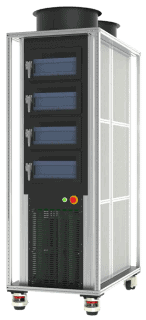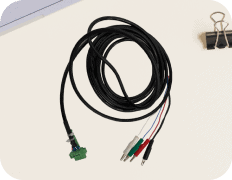Application Notes
How to run cyclic voltammetry on three-electrode(3E) cell using Arbin Tester
I. Introduction to 3E cell In a battery with 2 electrode, when you measure the battery voltage, you measure the potential difference between the cathode and anode of the battery. In this case, you only see the total difference in potentials and do not know how much each electrode contribute to this difference. You would […]
Read MoreHow to run cyclic voltammetry(CV) using Arbin Tester
Arbin continues to power innovation in many areas of battery research, including electrochemical experiments such as cyclic voltammetry (CV). Arbin equipment is designed to perform electrochemical experiments with the precise circuitry required for linear voltage ramps, while the MITS software gives the user a wide variety of options to create test schedule profiles. Understanding the […]
Read MoreHow to perform DC Internal Resistance measurement with Arbin?
Mechanism explanations: Arbin’s MITS software uses pulse method to calculate IR. In order to achieve better accuracy, the software measures the IR 10 times and takes the average. The pulse looks like the graph bellow: IIR is the amplitude value T2 is the extra control value1 I0 is the offset value IR Calculation Formula: IR […]
Read MoreEnhancing Battery Testing Safety with a Door Switch Interlock System
I. Purpose and Applicability Battery testing—whether for electric vehicles, consumer electronics, or industrial systems—demands strict safety protocols. One often overlooked but critical element in test chamber safety is the door switch interlock system. This simple yet powerful mechanism helps prevent injuries, equipment damage, and test data corruption. In this article, we’ll explore how door switch […]
Read MoreIntegration of Arbin Instruments with Gamry Potentiostats for High-Frequency EIS up to 2 MHz
According to the standard specifications published by Arbin, integrating a Gamry device with an Arbin system typically limits the device’s original frequency capability from 2 MHz down to 100 kHz. However, in this article, we will introduce a solution that allows the system to retain the full 2 MHz frequency, with some trade-offs to consider. Pre-Conditions for Achieving […]
Read MoreHow to perform Internal Resistance measurement according to IEC 61960 with Arbin?
IR measurement is crucial to have an insight into a battery. There are many way, i.e. many standard to measure battery’s IR. This article will introduce IEC 61960 standard and how to implement it using Arbin’s equipments. IEC 61960 standard for battery IR: In this standard, a discharge pulse of 0.2C is given for 10 […]
Read MoreIntegrated Electrochemical Impedance Spectroscopy (EIS) With Arbin Charge/Discharge Channels
Introduction Electrochemical Impedance Spectroscopy (EIS) is a foundational diagnostic technique for evaluating battery health, internal resistance, degradation mechanisms, and electrochemical behavior over time. However, EIS is traditionally limited by hardware complexity and high per-channel cost, making it difficult to scale across large battery test systems. To address these challenges, Arbin Instruments offers an integrated EIS […]
Read MoreHow to Test a Protection Circuit Module (PCM) Using ARBIN EOL
I. Purpose and Scope: The Protection Circuit Module (PCM) is a critical electronic component responsible for monitoring and protecting devices across a wide range of applications—from small consumer electronics to large-scale industrial equipment. Its core function is to ensure battery and device safety by preventing hazardous conditions such as overcharging, over-discharging, overcurrent, and short circuits […]
Read MoreAuxiliary Voltage Measurement
Introduction The Arbin Auxiliary Voltage Input Module enables precise, high-resolution voltage monitoring for battery testing applications that require measurements beyond the standard I/V channels. Typical use cases include monitoring individual cell or module voltages within a larger pack, measuring reference electrodes in three-electrode cells, or comparing BMS data with directly measured values. Each module supports […]
Read MoreAuxiliary Temperature Measurement
Introduction Battery temperature measurement is essential for evaluating safety, longevity, and performance in modern testing environments. Arbin supports three primary sensor technologies—thermocouples (Type T and K), RTDs (PT100), and thermistors (10kΩ)—each available through dedicated auxiliary input modules. These sensors enable precise temperature control, monitoring, and safety logic throughout battery R&D and production Description Battery testing […]
Read MoreConstant-C-rate w.r.t. actual capacity, rather than constant current with Arbin cyclers
As we all know, the batteries’ capacity degrade by cycle of charge and discharge. If we set the charge and discharge current of a fixed value, such as 1A, 2A,… the length of each cycle will gradually decreases, simply because the battery’s capacity decreases: Cycle time = (Charge Capacity + Discharge Capacity)/Current Sometimes users want […]
Read MoreSynchronize different battery charge/discharge channels in one environmental temperature chamber
MTCI Introduction Arbin’s MTCI (Multi-Temperature Chamber Interface) module offers seamless and sophisticated integration with third-party environmental chambers, enabling direct control of temperature and humidity setpoints from within the Arbin test schedule. This streamlined setup allows test engineers to program and adjust environmental conditions alongside electrical cycling parameters, eliminating the need for separate chamber control systems. […]
Read More



























